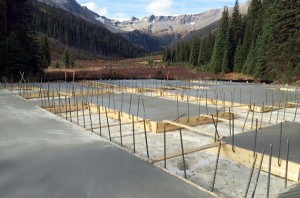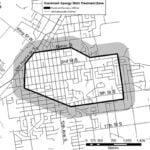Home »

Assessment shows building in avalanche path
By Chris Conway
An expert risk assessment has determined that building foundations at Jumbo Glacier Resort are located within an avalanche path capable of producing large destructive avalanches.
The foundations were constructed last fall in an effort to satisfy a “substantial development” deadline necessary for the company’s resort project to continue.
 The report, which is dated March 19, was prepared by Dynamic Avalanche Consulting Ltd. of Revelstoke. It presents a detailed risk assessment for the Pink Panther avalanche path and another nearby known as the Karnak path. The risk zones for the Karnak path were determined to not affect the foundations; however, the Pink Panther path does affect the foundation locations.
The report, which is dated March 19, was prepared by Dynamic Avalanche Consulting Ltd. of Revelstoke. It presents a detailed risk assessment for the Pink Panther avalanche path and another nearby known as the Karnak path. The risk zones for the Karnak path were determined to not affect the foundations; however, the Pink Panther path does affect the foundation locations.
The objectives of the report are; to determine the location of risk zones in relation to the foundations for the day-lodge and a nearby service building, provide guidance on building use, and make recommendations for hazard mitigation.
The Pink Panther avalanche path is capable of producing a size four avalanche which is of sufficient size to destroy buildings and/or forested areas up to four hectares.
According to the report, the Pink Panther avalanche start zone reaches an elevation of 2,700m with slope inclines up to 40°. The path descends to the valley bottom 1,718m with an average incline of 25°. Large avalanches occurring on this path may sweep over 200 m across the valley floor.
Dynamic referenced the Guidelines for Snow Avalanche Risk Determination and Mapping in Canada CAA, (2002), which states the generally accepted guidelines for land development and operations in avalanche terrain.
According to the Canadian Avalanche Association (CAA) guidelines, the established risk zones for land-use planning in avalanche terrain are as follows:
White Zone (low risk): Construction of new buildings, including permanently occupied structures, normally permitted.
Blue Zone (moderate risk): Construction of new buildings, such as industrial plants and temporarily occupied structures, possibly permitted with specified conditions.
Red Zone (high risk): Construction of new buildings not normally permitted.
Dynamic conducted a site visit on December 30, 2014. The avalanche paths were assessed in detail during a ground and aerial survey, and using other methods including: statistical and dynamic avalanche modelling, air photo interpretation, vegetation analysis, terrain/topographic analysis, and review of historical records.
Using this combined methodology, Dynamic determined the location of the risk zones relative to the foundations.
The report states that the majority of the service building foundation is located within the Red Zone (high risk); the remainder is located within the Blue Zone (moderate risk).
In respect to the day lodge, the report states that the majority of the foundation is located in the Blue Zone (moderate risk) and the remainder is located in the White Zone (low risk). The Red Zone (high risk) line is located approximately 25m from the day lodge foundation.
The report recommends that if a structure is to be constructed at the service building foundation, it should not be used during the winter season and should be structurally reinforced to withstand impact.
The report further recommends that if the day lodge is only used during limited work hours during the day, it may be considered as a temporarily occupied structure under the guidelines.
The guidelines state that construction of temporarily occupied structures may be permitted with specified conditions. In the case of the day-lodge the recommended conditions include structural reinforcement of the building, regular explosive control of the Pink Panther avalanche path, and an evacuation plan that may include short-term closures of the building during high-risk periods.
The report’s recommendations may not be sufficient to satisfy the BC Environmental Assessment Office (EAO).
On December 11, 2014 the EAO wrote to Glacier Resorts Ltd. regarding condition 36 of the company’s Environmental Assessment (EA) Certificate, which sets an exacting requirement regarding the location of structures at the resort.
According to the letter, condition 36 states that “residential and commercial structures will be located completely outside the avalanche hazard area.” The letter goes on to state that Glacier Resorts Ltd. is responsible for ensuring that the condition is met and emphasized that the condition applied to all buildings.
The letter requested Glacier Resorts Ltd. to conduct an engineering avalanche risk evaluation to inform the EAO’s compliance determination.
Meanwhile a decision remains pending from Environment Minister Mary Polak as to whether Glacier Resorts Ltd. met the EA Certificate’s “substantial development” requirement by the October 12, 2014 deadline. The company’s compliance with condition 36 is expected to be a critical factor affecting Minister Polak’s decision. If the certificate is withdrawn all further resort development will stop indefinitely.
Grant Costello, Senior Vice-President of Glacier Resorts Ltd. declined to provide any comment on the avalanche risk zoning report.
Mark Read, acting-chief administrative officer for the Jumbo Glacier Mountain Resort Municipality (JGMRM), stated that Glacier Resorts Ltd. has commissioned a further avalanche study. That report has not yet been released.
Lead image: A screen shot of one of the maps forming part of the Dynamic Avalanche Consulting Ltd. report.







